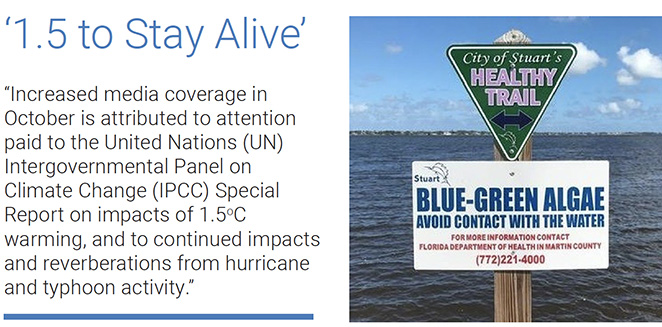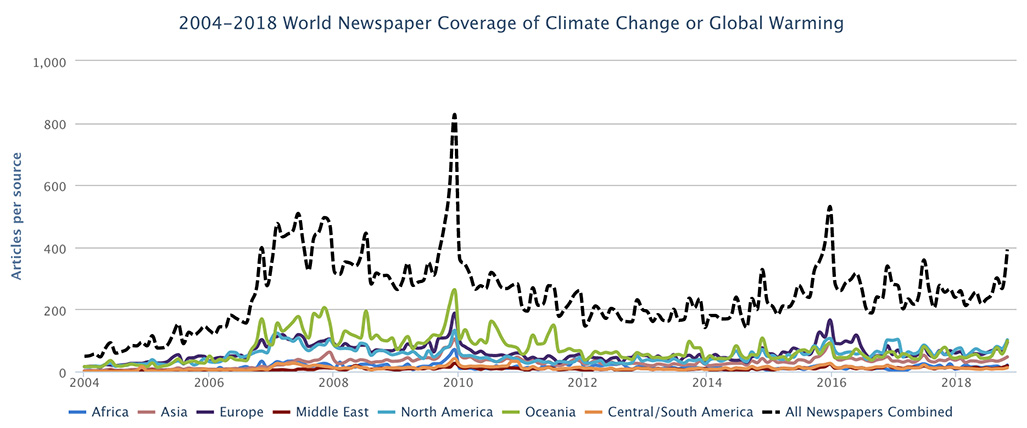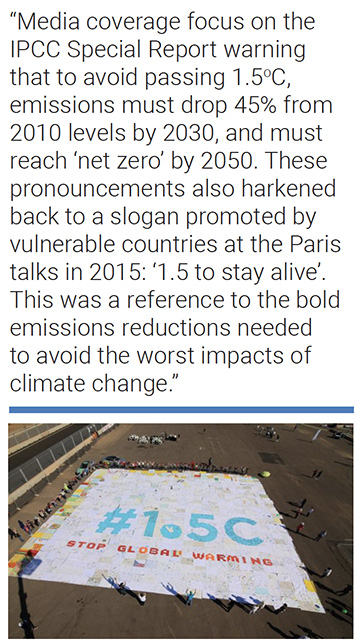Monthly Summaries
Issue 22, October 2018
[DOI]

A sign on the waterfront in Stuart, Florida, where toxic algal blooms earlier this fall killed sea life and sickened residents. (Evan Halper/Los Angeles Times)
October media attention to climate change and global warming was up 43% throughout the world from the previous month of September 2018, and more than doubled (up 51%) from October last year. Upticks were detected across all regions of the world in October. Increased media coverage in October is attributed to attention paid to the United Nations (UN) Intergovernmental Panel on Climate Change (IPCC) Special Report on impacts of 1.5°C warming, and to continued impacts and reverberations from hurricane and typhoon activity. An increase was most pronounced in Africa (up 79%) and Oceania (up 76%). Elsewhere, increases were also detected in Central/South America (up 40%), North America (up 37%), Asia (up 24%) and Europe (up 43%), compared to the previous month of September.
In January of this year, MeCCO expanded coverage to sixty-two newspaper sources, six radio sources and six television sources. These span across thirty-eight countries, in English, Spanish, German and Portuguese. In addition to English-language searches of “climate change” or “global warming”, we search Spanish-language sources through the terms "cambio climático" or "calentamiento global", German-language sources through the terms ‘klimawandel’ or ‘globale erwärmung’, and Portuguese-language sources through the terms "mudanças climáticas" or "aquecimento global". Figure 1 shows these ebbs and flows in newspaper media coverage at the global scale – organized into seven geographical regions around the world – over the past 178 months (from January 2004 through October 2018).

Figure 1. Newspaper media coverage of climate change or global warming in sixty-two sources across thirty-five countries in seven different regions around the world, from January 2004 through October 2018.
 Moving to considerations of content within these searches, Figure 2 shows word frequency data in the dynamic spaces of US newspaper and television media coverage in October 2018.
Moving to considerations of content within these searches, Figure 2 shows word frequency data in the dynamic spaces of US newspaper and television media coverage in October 2018.
Figure 2. Word cloud showing frequency of words (4 letters or more) invoked in media coverage of climate change or global warming in the United States television sources.
In October, considerable attention was paid to political content of coverage. The lead up to the 2018 US elections on November 6 have had some bearing on coverage. For example, in an article titled ‘As climate change becomes more visible, its weight as a campaign issue is growing’ journalist Evan Halper from the Los Angeles Times wrote, “for years, conventional wisdom among political strategists has labeled climate change as a politically weak issue, a concern of environmental activists but not the mass of voters. That’s still the case in many areas. But in districts around the country where warming is exacerbating natural disasters and disrupting regional economies, the anxiety of voters like Hardwick has started to shift how candidates campaign”. Meanwhile, in Canada in October, the government announced that they will impose carbon taxes on provinces that fail to create their own policies. The Prime Minister announced that the funds generated in Ontario, Manitoba, Saskatchewan and New Brunswick, will go back to the taxpayers. Reuters journalist David Rjunggren reported on this effort at the Canadian federal level, and this story ran in many other outlets throughout the country and beyond. He wrote, “Canadian Prime Minister Justin Trudeau on Tuesday said he would fulfill a promise to impose a carbon tax on provinces unwilling to combat climate change, prompting instant protests from a voter-rich part of the country. Trudeau, whose ruling Liberals face an election in October 2019, told a news conference that all the money collected would be returned directly to taxpayers in the four provinces without plans to curb the emission of greenhouse gases. Starting in April 2019 carbon pollution will initially cost C$20 ($15.27) a tonne, rising by C$10 a year until it reaches C$50 in 2022. Ottawa unveiled the proposal in 2016”.
At the science-policy interface, an early October UN IPCC meeting in South Korea – and consequent Special Report on impacts of 1.5°C warming – garnered a great deal of media attention. Media coverage focus on the IPCC Special Report warning that to avoid passing 1.5°C, emissions must drop 45% from 2010 levels by 2030, and must reach ‘net zero’ by 2050. These pronouncements also harkened back to a slogan promoted by vulnerable countries at the Paris talks in 2015: ‘1.5 to stay alive’. This was a reference to the bold emissions reductions needed to avoid the worst impacts of climate change. BBC journalist Matt McGrath reported on how delegates gathered in Incheon, South Korea “to hammer out a plan in co-operation with government delegates, on the actions that would need to be taken to meet this [1.5°C] goal”. Amid considerable coverage of this report, Wall Street Journal reporter Timothy Puko wrote, “rapid, far-reaching changes to almost every facet of society are needed to avoid catastrophic climate change, reforms far beyond anything governments are currently either doing or planning to do, according to a report from a United Nations-led scientific panel”. Journalist Doyle Rice from USA Today reported, “ the world’s economies must quickly reduce fossil fuel use while at the same time dramatically increasing use of clean, efficient energy. These transitions must start now and be well underway in the next 20 years”.
 Moving to media accounts focused on primarily scientific dimensions of climate change and global warming, the National Academies of Sciences published a report on October 24 called ‘Negative Emissions Technologies and Reliable Sequestration: A Research Agenda’. The report picked up on the ‘negative emissions technologies’ portion of the IPCC special report. It plainly stated that there needs to be strong leadership to support the scaling up of carbon removal technologies to remove about 10 billion tons (10 Gigatons/Petagrams) of carbon from the atmosphere by mid-century to avoid the worst impacts of climate change. Associated Press reporter Seth Borenstein wrote that the National Academy of Sciences report says that the scale of aggressive action by 2050 is akin to removing “the equivalent of about twice the yearly emissions of the US”.
Moving to media accounts focused on primarily scientific dimensions of climate change and global warming, the National Academies of Sciences published a report on October 24 called ‘Negative Emissions Technologies and Reliable Sequestration: A Research Agenda’. The report picked up on the ‘negative emissions technologies’ portion of the IPCC special report. It plainly stated that there needs to be strong leadership to support the scaling up of carbon removal technologies to remove about 10 billion tons (10 Gigatons/Petagrams) of carbon from the atmosphere by mid-century to avoid the worst impacts of climate change. Associated Press reporter Seth Borenstein wrote that the National Academy of Sciences report says that the scale of aggressive action by 2050 is akin to removing “the equivalent of about twice the yearly emissions of the US”.
Later in the month, the World Health Organization (WHO) released a report on ambient outdoor air quality, climate change and public health. Among their findings, they reported that 93% of the world’s children are exposed to fine particulate matter levels above WHO air quality guidelines, and ambient and household air pollution caused 7 million deaths (600,000 children) globally in 2016. Journalist Matthew Taylor from The Guardian wrote “the study found that more than …1.8 billion children are breathing toxic air, storing up a public health time bomb for the next generation. The WHO said medical experts in almost every field of children’s health are uncovering new evidence of the scale of the crisis in both rich and poor countries – from low birth weight to poor neurodevelopment, asthma to heart disease”. CNN journalist Mary McDougall reported, “ Air pollution is one of the leading threats to health in children under 5, accounting for almost one in 10 deaths among this age group”.
Also in late October, the World Wildlife Fund released its biannual report tracking climate and environmental impacts on more than 4,000 species of mammals, birds, fish, reptiles and amphibians. Among their findings, they noted that 60% of wildlife on planet Earth has disappeared since 1970. They attribute this to over harvesting of natural resources and contributions to climate change. The report has calculated that wildlife extinction rates are now up to 1,000 times higher than they were before human involvement in ecosystems, and predicts that the amount of habitat in the world uninfluenced by human activity will shrink from 25 percent today to just 10 percent in 2050. Journalist Ashley May from USA Today wrote, “the Living Planet Report, which publishes every two years, tracked more than 4,000 species of mammals, birds, fish, reptiles and amphibians. Declines are worst in the tropics, according to the data, as South and Central America saw an 89 percent decrease. Also, freshwater species saw an 83 percent drop, threatened by factors including overfishing, pollution and climate change...The report estimates that only a quarter of the world's land is untouched by humans, who are increasing food production and use of natural resources. America is among the countries using the most natural resources, according to a WWF map showing North America and Canada consuming more than seven global hectares per person”.
Also this month (as was the case in September), there was coverage crossing ecological and meteorological themes that discussed hurricane activity and climate change. While many have continued to critique media in that there isn’t enough…hurricane Michael did generate connections in some media accounts. For example, on October 10 as the hurricane came on land in the US Florida panhandle, CNN journalists Susannah Cullinane, Jason Hanna and Faith Karimi reported, “a terrifyingly powerful Category 4 Hurricane Michael was poised to become the strongest hurricane to hit the Florida Panhandle in recorded history Wednesday, its rapid strengthening catching some by surprise and leaving anxious officials telling those who didn't evacuate: It's time to hunker down”. A day later on October 11, Reuters journalist John Herskovitz wrote, “Michael was not the only tropical cyclone in recent years to undergo what scientists refer to as “rapid intensification,” defined as an acceleration of wind speeds of at least 35 mph (56 kph) in 24 hours or less. The phenomenon has become more serious as sea waters have warmed with climate change”. Meanwhile, Guardian journalists Daniel Levitt and Niko Kommenda posed the question ‘is climate change making hurricanes worse?’ and CNN journalist John D. Sutter reported, “Hurricane Michael isn't a truly ‘natural disaster’. Neither was Harvey in Houston. Nor Maria in Puerto Rico. Yet we continue to use that term. Doing so -- especially in the era of climate change -- is misleading if not dangerous, according to several disaster experts and climate scientists...” On October 12, as residents and authorities began to assess the damage of the powerful Category 4 strength storm upon landfall, in a New York Times article by journalists Chris Dixon and Campbell Robertson titled ‘They Were Still Recovering from Hurricane Florence. Then Michael Came.’, they quoted a local resident who commented “The county and state can sweep it under the rug…but it’s only going to get worse. This is going to continue”.
Later in October, Typhoon Yutu struck the US Northern Marianas island territories of Saipan and Tinian in the Pacific Ocean. The category 5 storm was reported by outlets like National Public Radio to be the strongest storm this hurricane season and the most powerful system to hit the US since 1935. While numerous stories covering the Typhoon failed to make links between weather and climate change (see for example), journalists Chris Mooney, Juliet Eilperin and Allyson Chiu from The Washington Post explicitly connected the behavior of the storm to larger changes in the climate. They wrote, “overall, the escalating impacts on U.S. island territories in the Pacific and Caribbean underscore that as seas rise and storms worsen with climate change, small islands face some of the most extreme risks on Earth. Many have organized into the Alliance of Small Island States to push for strong action to curb global warming. Puerto Rico, the U.S. Virgin Islands, Guam and American Samoa are affiliated with the organization”.
Some news stories in October sought to plainly make the connection for others. For example, journalist Henry Fountain from The New York Times wrote a piece entitled ‘The Hurricanes, and Climate-Change Questions, Keep Coming. Yes, They’re Linked’. Here he discussed how hurricanes are getting stronger and intensifying faster through human contributions to climate change, as well as how they have more rain associated with them and they are moving more slowly. (These four elements plus stronger storm surge due to sea level rise incidentally comprise the ‘five fingers of f#&k’ that connect hurricanes and climate change). As another example, in an article entitled ‘The planet is on a fast path to destruction. The media must cover this like it’s the only story that matters’, Margaret Sullivan in The Washington Post commented, “In short, when it comes to climate change, we — the media, the public, the world — need radical transformation, and we need it now. Just as the smartest minds in earth science have issued their warning, the best minds in media should be giving sustained attention to how to tell this most important story in a way that will creates change. We may be doomed even if that happens. But we’re surely doomed if it doesn’t”.
Across the globe in October, there was a range of stories that intersected with the cultural arena. For example, stories circulated about how Yale University economist William Nordhaus was awarded a Nobel Prize for his work on climate change economics and carbon taxation. Journalist Binyamin Applebaum of The New York Times wrote that “the Yale economist William D. Nordhaus has spent the better part of four decades trying to persuade governments to address climate change, preferably by imposing a tax on carbon emissions…But Professor Nordhaus sadly noted that he hadn’t convinced the government of his own country.” Washington Post journalist Taylor Telford noted, “Economic Sciences for their work on the relationship of climate change and technological innovation to economics, which has profoundly shaped policy around the world.”
Other news coverage was generated from a report that nearly fifty UNESCO World Heritage sites in the Mediterranean were vulnerable to climate change-related impacts such as sea level rise and storm, storm surge and coastal erosion. Washington Post reporters Chris Mooney and Brady Dennis quoted lead study author Lena Reimann, who said, “What surprised me the most is that actually even under current conditions, there are so many World Heritage sites that are at risk”.
Autumn has gripped the Northern Hemisphere, and we at the Media and Climate Change Observatory will continue to get a grip on media attention to climate change, amid competing interests in other political, social, environmental, economic, and cultural issues around the globe.
